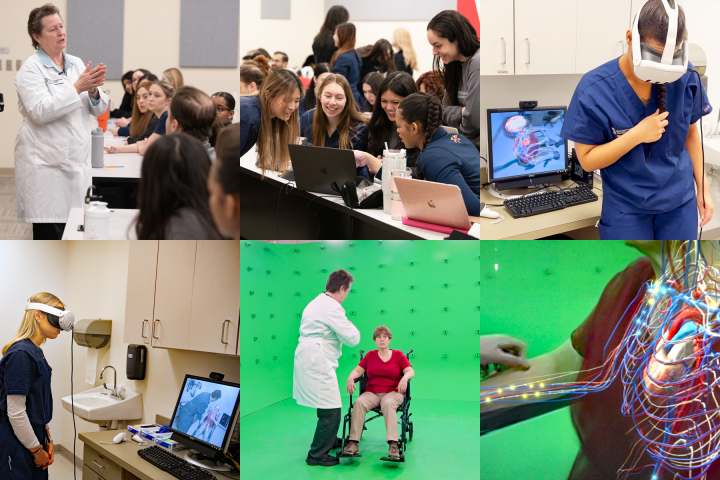A New Reality For Physician Assistant Students
“Today is gonna be a really, really fun day for you,” Assistant Dean for Physician Assistant Education and Associate Professor Cheri Hendrix, DHEd, MSBME, PA-C, DFAAPA, told her class of 58 physician assistant (PA) students. In truth, it would be hard to say just who would have the most fun, the students who sat in anticipation of an exciting new high-tech learning experience, or Hendrix, who waited a very long time for this day to arrive.
“I think this is really going to enrich what you know about neurologic disease,” she continued, understating her expectations a bit. For the first time, this learning module made use of virtual reality (VR) technology, offering her entire didactic year cohort an immersive experience. With the use of VR headsets, the students would be virtually in the room with Hendrix as she examined a standardized patient – a professional actor posing as a patient who was presenting with signs of distress. The plan was to give the students a brief knowledge test before their VR experience, and then another test afterward to see how much this experience improved their understanding.
Student Lauren Makarehchi was among the first in the group to experience the virtual exam.
“I feel like I'm actually there, even though I can't see my hands or anything. But it's like, I feel like I'm very immersed in the experience,” she said with her headset still on. Not only could Makarehchi see the exam, but she could also move around the room and observe provider and patient from every angle. Additionally, as the patient described her experiences for Hendrix – all classic symptoms of a stroke – an animated graphical overlay allowed Makarehchi and the other students to see what was going on inside the patient’s body, including the nervous and cardiovascular systems.
“I can see that the clot started in her atrium, went up to the left side of her brain, and now you can see the impulses are being limited on the right side of her body, which is causing the motor and sensory limitations that we can see on the exam,” explained student Meg Rice. After her five-minute virtual experience, Rice seemed impressed.
“It's a total game changer to kind of be able to be in the room with them, seeing what's going on in real time, basically as she does the exam and asks the different questions. And you know how what's going on inside of her body is influencing her answers and her symptoms and her signs all in real time. So, that's really cool,” she said, adding, “When I get to clinicals next year, if I have a patient with a similar situation, I can kind of have this picture in my brain of what might be going on.”
Every student appeared to have a similar impression and most were quick to see the impact virtual reality training might have on their ability to retain what they learn.
“I think this kind of experience will change the way you look at patients for sure, because now I'm able to remember seeing inside and what's happening,” said student Simone Hill. “It's one thing to see someone presenting physically with their complaints, but then when you have experiences like this, you're able to remember, okay, I remember seeing what this looks like from the inside. I remember seeing which part of the brain was impacted by this and where the blockages were and where the vessels were flowing through.”
Classmate Eugene Obeng-Appiah agreed. “If I see a patient who presents with certain symptoms, I can, you know, go back to that memory that I have of what I saw. And so that would allow me to be able to put pieces together a little bit more and faster as well, I think.”
The ability to retain and recall a huge and wide array of information is precisely what Hendrix and her colleagues are trying to gauge.
“We have 24 months to get three and a half years of medical school in them,” Hendrix explained. “How do you do that so that the understanding is there, the knowledge is there? And the application of that, you've got to apply these medical concepts. You can't memorize this.”
In those 24 months, PA students must master topics such as anatomy, clinical practice, diagnostic tests, and disease over many disciplines, including family medicine, internal medicine, pediatric medicine, women's health, psychiatric medicine, behavioral health, emergency medicine, and surgery.
To fill that very tall order, Hendrix can rely on her skilled team in the University of Maryland School of Graduate Studies (SGS). But to step up the impact of their training, to help students get to what she calls “A-Ha!” moments faster, Hendrix wanted students in the classroom to get as close as possible to the real thing with virtual reality. For that, she called in another team, this one from the University of Maryland, College Park’s College of Computer, Mathematical, and Natural Sciences. Dean Amitabh Varshney, PhD, is a pioneer in the application of high-performance computing and visualization in engineering, science, and medicine.
Click HERE to read the full article
The Department welcomes comments, suggestions and corrections. Send email to editor [-at-] cs [dot] umd [dot] edu.
